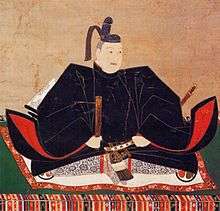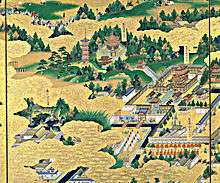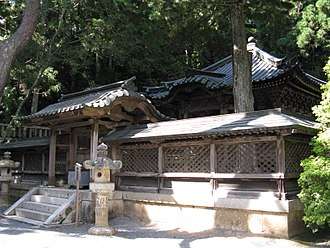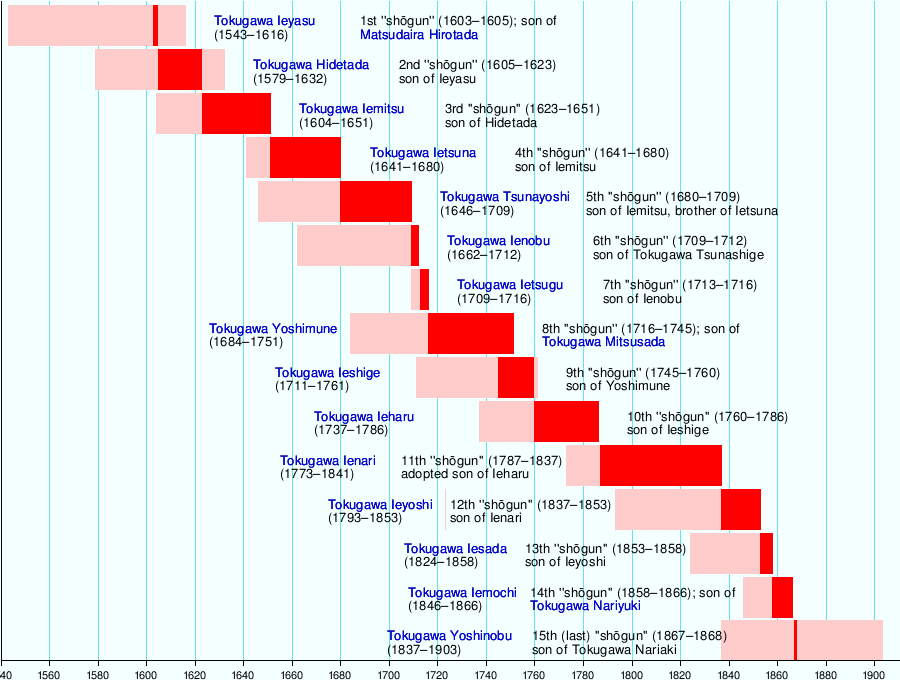Tokugawa Hidetada
| Tokugawa Hidetada | |
|---|---|
 | |
| Shōgun | |
|
In office 1605–1623 | |
| Monarch |
Go-Yōzei Go-Mizunoo |
| Preceded by | Tokugawa Ieyasu |
| Succeeded by | Tokugawa Iemitsu |
| Personal details | |
| Born | May 2, 1579 |
| Died | March 14, 1632 (aged 52) |
| Children |
Among Others... |
| Mother | Saigō-no-Tsubone |
| Father | Tokugawa Ieyasu |
| Military service | |
| Allegiance |
|
| Unit |
|
| Battles/wars |
Siege of Ueda Siege of Osaka |
Tokugawa Hidetada (徳川 秀忠, May 2, 1579 – March 14, 1632) was the second shōgun of the Tokugawa dynasty, who ruled from 1605 until his abdication in 1623. He was the third son of Tokugawa Ieyasu, the first shōgun of the Tokugawa shogunate.
Early life (1579–1593)
Tokugawa Hidetada was born to Tokugawa Ieyasu and the Lady Saigō (the first of his many consorts) on May 2, 1579. This was shortly before Lady Tsukiyama, Ieyasu's official wife, and their son Tokugawa Nobuyasu were executed on suspicion of plotting to assassinate Oda Nobunaga, who was Nobuyasu's father-in-law and Ieyasu's ally. By killing his wife and son, Ieyasu declared his loyalty to Nobunaga. In 1589, Hidetada's mother fell ill, her health rapidly deteriorated, and she died at Sunpu Castle. Later Hidetada with his brother, Matsudaira Tadayoshi, was raised by Achaa no Tsubone, one of Ieyasu's concubines. His childhood name was Chomaru (長丸) later become Takechiyo (竹千代).
The traditional power base of the Tokugawa clan was Mikawa. In 1590, the new ruler of Japan, Toyotomi Hideyoshi enlisted Tokugawa Ieyasu and others in attacking the domain of the Hōjō in what became known as the Siege of Odawara (1590). Hideyoshi enlisted Ieyasu for this campaign by promising to exchange the five provinces under Ieyasu's control for the eight Kantō provinces, including the city of Edo. In order to keep Ieyasu from defecting to the Hōjō side (since the Hōjō and the Tokugawa were formerly on friendly terms), Hideyoshi took the eleven-year-old Hidetada as a hostage. In 1592 Hideyoshi presided over Hidetada's coming of age ceremony; it was then that Ieyasu's son dropped his childhood name, Takechiyo (竹千代), and assumed the name Hidetada. He was named the heir of the Tokugawa family, being the eldest surviving son of Ieyasu, and his favorite (since Ieyasu's eldest son had been previously executed, and his second son was adopted by Hideyoshi while still an infant). In 1593, Hidetada returned to his father's side.
In 1590 Hidetada married O-Hime (1585–1591), daughter of Oda Nobukatsu and adopted daughter of Toyotomi Hideyoshi. O-Hime died in 1591, and was given the posthumous Buddhist name Shunshoin. In 1595, Hidetada married Oeyo, daughter of Azai Nagamasa and adopted daughter of Toyotomi Hideyoshi. Their wedding was held in Fushimi Castle.
Military achievements (1593–1605)
In 1595, Hidetada married Oeyo of the Oda clan and they had two sons, Tokugawa Iemitsu and Tokugawa Tadanaga.[1] They also had two daughters, one of whom, Senhime, married twice. The other daughter, Kazuko hime, married Emperor Go-Mizunoo (of descent from the Fujiwara clan).[2]
Knowing his death would come before his son Toyotomi Hideyori came of age, Hideyoshi named five regents—one of whom was Hidetada's father, Ieyasu—to rule in his son's place. Hideyoshi hoped that the bitter rivalry among the regents would prevent any one of them from seizing power. But after Hideyoshi died in 1598 and Hideyori became nominal ruler, the regents forgot all vows of eternal loyalty and were soon vying for control of the nation. Tokugawa Ieyasu was one of the strongest of the five regents, and began to rally around himself an Eastern faction. A Western faction rallied around Ishida Mitsunari. The two factions clashed at the Battle of Sekigahara in 1600. Ieyasu won decisively, which set the stage for Tokugawa rule.
Hidetada had led 16,000 of his father's men in a campaign to contain the Western-aligned Uesugi clan in Shinano. Ieyasu then ordered Hidetada to march to Sekigahara in anticipation of the decisive battle against the Western faction. But the Sanada Clan managed to tie down Hidetada's force, so he arrived too late to assist in his father's narrow but decisive victory. Hidetada and Ieyasu's relationship never recovered. On 3 December 1601, Hidetada's first son, Chōmaru (長丸), was born to a young maiden from Kyoto named Onatsu. In September 1602, Chōmaru fell ill and died; his funeral was held at Zōjō-ji temple in Shibe.
In 1603 Emperor Go-Yōzei granted Ieyasu the title of shōgun. Thus Hidetada became the heir to the shogunate.
Shōgun (1605–1623)
To avoid his predecessor's fate, Ieyasu established a dynastic pattern soon after becoming shogun by abdicating in favor of Hidetada in 1605. Ieyasu retained significant power until his death in 1616; but Hidetada nevertheless assumed a role as formal head of the bakufu bureaucracy.[3]
Much to the dismay of Ieyasu, in 1612, Hidetada engineered a marriage between Sen, Ieyasu's favorite granddaughter, and Toyotomi Hideyori, who was living as a commoner in Osaka Castle with his mother. When this failed to quell Hideyori's intrigues, Ōgosho Ieyasu and Shogun Hidetada brought an army to Osaka.[4] Father and son once again disagreed on how to conduct this campaign against the recalcitrant Toyotomi forces in Osaka. In the ensuing siege Hideyori and his mother were forced to commit suicide. Even Hideyori's infant son (Kunimatsu), that he had with a concubine, was not spared. Only Sen was spared; she later remarried and had a new family.
After Ieyasu's death in 1616,[4] Hidetada took control of the bakufu. He strengthened the Tokugawa hold on power by improving relations with the Imperial court. To this end he married his daughter Kazuko to Emperor Go-Mizunoo.[4] The product of that marriage, a girl, eventually succeeded to the throne of Japan to become Empress Meishō. The city of Edo was also heavily developed under his reign.
Ogosho (1623–1632)

In Genna 9 (1623) Hidetada resigned the government to his eldest son and heir, Tokugawa Iemitsu.[5] Like his father before him, Hidetada became Ōgosho or retired shōgun, and retained effective power. He enacted draconian anti-Christian measures, which Ieyasu had only considered: he banned Christian books, forced Christian daimyōs to commit suicide, ordered all other Christians to apostatize, and executed the fifty-five Christians (both Japanese and foreign) who refused to renounce Christianity or to go into hiding, in Nagasaki in 1628.
Ōgosho Hidetada died in Kan'ei 9, on the 24th day of the 1st month (March 14, 1632).[5] His Buddhist posthumous name is Daitoku-in (台徳院).[6] His ashes were ceremoniously laid to rest in the Taitoku-in Mausoleum in Edo.

Honours
- Senior First Rank (March 30, 1632; posthumous)
Eras
The years in which Hidetada was shōgun are more specifically identified by more than one era name or nengō.[4]
Family
- Father: Tokugawa Ieyasu
- Mother: Saigō-no-Tsubone
- Adopted Mother: Acha no Tsubone (1555–1637)
- Siblings from Mother:
- Saigo Katsusada
- Toku-hime
- Wife:
- O-Hime (1585–1591), daughter of Oda Nobukatsu later Shunshoin.
- Oeyo, daughter of Asai Nagamasa and Oichi
- Concubines
- Onatsu no Kata
- Oshizu no Kata (1584–1635) later Jōkōin
- Children:
- Senhime
- Tama-hime (August 1, 1599 – August 9, 1622)
- Katsu-hime (June 12, 1601 – March 20, 1672) married Matsudaira Tadanao
- Chomaru (3 December 1601– September 1602) later Shutokuinden born by Onatsu no Kata
- Hatsu-hime (August 25, 1602 – April 16, 1630) married Kyōgoku Tadataka
- Tokugawa Iemitsu
- Tokugawa Tadanaga
- Tokugawa Masako
- Hoshina Masayuki born by Oshizu no Kata later Jōkōin
- Adopted Daughters:
- Toyotomi Sadako (1593–1658) daughter of Toyotomi Hidekatsu with Oeyo, later married Kujō Yukiie and had 2 Sons: Nijō Yasumichi and Kujō Michifusa.(Hidekatsu was Oeyo's former husband who died in Japanese Invasions of Korea)
- Chiyohime (1597–1649), daughter of Ogasawara Hidemasa and Toku-hime (Tokuhime was daughter of Matsudaira Nobuyasu) and married Hosokawa Tadatoshi had 1 son: Hosokawa Mitsunao of Kumamoto Domain
- Katsuhime (1618–1678), daughter of Senhime with Honda Tadatoshi and married Ikeda Mitsumasa, had 1 son and 1 daughter: Ikeda Tsunamasa, Torihime
- Kamehime (1617–1681), daughter of Katsuhime with Matsudaira Tadanao and married Takamatsu no Miya Yoshihito-Shinnō
- Kisahime (1598–1656), daughter of Yūki Hideyasu and married Mōri Hidenari had 1 son: Mori Tsunanori of Chōshū Domain
- Binhime (1607–1652) daughter of Okudaira Iemasa of Utsunomiya Domain and married Horio Tadaharu had 1 daughter married Ishikawa Kadokatsu
- Furuhime (1607–1659), daughter of Ikeda Terumasa with Tokuhime (Tokuhime was Hidetada's sister) and married Date Tadamune had 2 sons and 1 daughter: Torachiyo, Date Mitsumune, and Nabehime married Tachibana Tadashige
- Tsuruhime (d. 1672), daughter of Sakakibara Yasumasa and married Ikeda Toshitaka of Himeji Domain had 1 son: Ikeda Mitsumasa
- Hisahime (1606–1628) daughter of Matsudaira Tadayoshi of Sekiyado Domain and married Kuroda Tadayuki of Fukuoka Domain
- Takashi-ho-in (1602–1656), daughter of Gamō Hideyuki with Furihime (Hidetada's younger sister) and married Kato Tadahiro of Kumamoto Domain had 1 son: Katō Mitsuhiro
- daughter of Okada Mototsugu and married Soma Toshitane of Soma Nakamura Domain
Ancestry
| Ancestors of Tokugawa Hidetada | |||||||||||||||||||||||||||||||||||||||||||||||||||||||||||||||||||||||||||||||||||||||||||||||||||||||||||||||||||||||||||||||||||||||||||||||||||||||||||||||||||||||||||||||||||||||||||||||||||||||||||||||||||||||||||||||||||||||||||||||||||||||||||||||||||||||||||||||||||||||||||||||||||||||||||||||||||||||||||||||||||||||||||||||||||||||||||||||||||||||||||||||||||||||||||||||||||||||||||||||||||||||||||||||||||||||||||||||||||||||||||||||||||||||||||||||||||||||||||||||||||||||||||||||||||||||||||||||||||||||||||||||||||||||||||||
|---|---|---|---|---|---|---|---|---|---|---|---|---|---|---|---|---|---|---|---|---|---|---|---|---|---|---|---|---|---|---|---|---|---|---|---|---|---|---|---|---|---|---|---|---|---|---|---|---|---|---|---|---|---|---|---|---|---|---|---|---|---|---|---|---|---|---|---|---|---|---|---|---|---|---|---|---|---|---|---|---|---|---|---|---|---|---|---|---|---|---|---|---|---|---|---|---|---|---|---|---|---|---|---|---|---|---|---|---|---|---|---|---|---|---|---|---|---|---|---|---|---|---|---|---|---|---|---|---|---|---|---|---|---|---|---|---|---|---|---|---|---|---|---|---|---|---|---|---|---|---|---|---|---|---|---|---|---|---|---|---|---|---|---|---|---|---|---|---|---|---|---|---|---|---|---|---|---|---|---|---|---|---|---|---|---|---|---|---|---|---|---|---|---|---|---|---|---|---|---|---|---|---|---|---|---|---|---|---|---|---|---|---|---|---|---|---|---|---|---|---|---|---|---|---|---|---|---|---|---|---|---|---|---|---|---|---|---|---|---|---|---|---|---|---|---|---|---|---|---|---|---|---|---|---|---|---|---|---|---|---|---|---|---|---|---|---|---|---|---|---|---|---|---|---|---|---|---|---|---|---|---|---|---|---|---|---|---|---|---|---|---|---|---|---|---|---|---|---|---|---|---|---|---|---|---|---|---|---|---|---|---|---|---|---|---|---|---|---|---|---|---|---|---|---|---|---|---|---|---|---|---|---|---|---|---|---|---|---|---|---|---|---|---|---|---|---|---|---|---|---|---|---|---|---|---|---|---|---|---|---|---|---|---|---|---|---|---|---|---|---|---|---|---|---|---|---|---|---|---|---|---|---|---|---|---|---|---|---|---|---|---|---|---|---|---|---|---|---|---|---|---|---|---|---|---|---|---|---|---|---|---|---|---|---|---|---|---|---|---|---|---|---|---|---|---|---|---|---|---|---|---|---|---|---|---|---|---|---|---|---|---|---|---|---|---|---|---|---|---|---|---|---|---|---|---|---|---|---|---|---|---|---|---|---|---|---|---|---|---|---|---|---|---|---|---|---|---|---|---|---|---|---|---|---|---|---|---|---|---|---|---|---|---|---|---|---|---|---|---|---|---|---|---|---|---|---|---|---|---|---|---|---|---|---|---|---|---|---|---|---|---|---|---|---|---|---|---|---|---|---|---|---|---|---|---|---|---|---|---|---|---|
| |||||||||||||||||||||||||||||||||||||||||||||||||||||||||||||||||||||||||||||||||||||||||||||||||||||||||||||||||||||||||||||||||||||||||||||||||||||||||||||||||||||||||||||||||||||||||||||||||||||||||||||||||||||||||||||||||||||||||||||||||||||||||||||||||||||||||||||||||||||||||||||||||||||||||||||||||||||||||||||||||||||||||||||||||||||||||||||||||||||||||||||||||||||||||||||||||||||||||||||||||||||||||||||||||||||||||||||||||||||||||||||||||||||||||||||||||||||||||||||||||||||||||||||||||||||||||||||||||||||||||||||||||||||||||||||
Notable descendants
Notable descendants of Tokugawa Hidetada, by his wife Oeyo, include:
- Senhime – Daughter, married Toyotomi Hideyori and later married Honda Tadatoki
- Kochiyo (1619–1621)
- Katsuhime (1618–1678) married Ikeda Mitsumasa
- Tsuhime (1636–1717) married Ichijō Norisuke
- Ikeda Tsunamasa
- Ikeda Tsugumasa
- Ikeda Munemasa
- Ikeda Harumasa (1750–1819)
- Ikeda Narimasa (1779–1833)
- Sagara Nagahiro (1752–1813)
- Sagara Yorinori (1774–1856)
- Sagara Yoriyuki (1798–1850)
- Ikeda Akimasa (1836–1903)
- Ikeda Narimasa (1865–1909)
- Ikeda Tadamasa (1895–1902)
- Ikeda Nobumasa (1904–1988)
- Ikeda Takamasa (1926–2012) married Atsuko Ikeda
- Ikeda Narimasa (1865–1909)
- Ikeda Akimasa (1836–1903)
- Sagara Yoriyuki (1798–1850)
- Sagara Yorinori (1774–1856)
- Ikeda Harumasa (1750–1819)
- Ikeda Munemasa
- Ikeda Tsugumasa
- Tama-hime married Maeda Toshitsune
- Maeda Toshitsugu
- Maeda Masatoshi (1649–1706)
- Manhime (1618–1700) married Asano Mitsuakira
- Asano Naganao (1644–1666)
- Asano Nagateru (1652–1702)
- Asano Tsunaakira
- Asano Tsunanaga
- Asano Yoshinaga
- Asano Munetsune
- Asano Shigeakira
- Asano Narikata
- Asano Nagatoshi
- Asano Nagamichi
- Asano Toshitsugu
- Asano Nagayuki
- Asano Nagatake
- Asano Nagayoshi
- Asano Nagataka (b. 1956)
- Asano Nagayoshi
- Asano Nagatake
- Asano Nagayuki
- Asano Toshiteru
- Asano Shigeakira
- Asano Munetsune
- Asano Yoshinaga
- Asano Tsunanaga
- Komatsuruhime (1613–1630) married Mōri Tadahiro
- Tomi-hime (1621–1662)
- Maeda Mitsutaka
- Maeda Tsunanori
- Maeda Toshiaki (1691–1737)
- Maeda Toshimichi (1737–1781)
- Maeda Toshitoyo (1771–1836)
- Maeda Toshihiro (1823–1877)
- Maeda Toshiaki (1850–1896)
- Toshinari Maeda
- Maeda Toshitatsu (1908–1989)
- Maeda Toshihiri (b. 1935)
- Maeda Toshitaka (b. 1963)
- Maeda Toshikyo (b. 1993)
- Maeda Toshitaka (b. 1963)
- Maeda Toshihiri (b. 1935)
- Maeda Toshitatsu (1908–1989)
- Toshinari Maeda
- Maeda Toshiaki (1850–1896)
- Maeda Toshihiro (1823–1877)
- Maeda Toshitoyo (1771–1836)
- Maeda Toshimichi (1737–1781)
- Maeda Yoshinori
- Maeda Munetoki
- Maeda Shigehiro
- Maeda Shigenobu
- Maeda Harunaga
- Maeda Shigemichi
- Maeda Narinaga
- Maeda Nariyasu
- Maeda Yoshiyasu
- Yoshitsugu Maeda (1858–1900)
- Maeda Yoshiyasu
- Maeda Nariyasu
- Maeda Narinaga
- Maeda Toshiaki (1691–1737)
- Maeda Tsunanori
- Maeda Toshitsugu
- Katsuhime, married Matsudaira Tadanao
- Matsudaira Mitsunaga (1616–1707) of Takada Domain
- Matsudaira Tsunakata (1633–1674)
- Kamehime (1617–1681) married Takamatsu no Miya Yoshihito-Shinno, son of Emperor Go-Yōzei
- Princess Akiko (1638-1680) married Emperor Go-Sai
- Imperial Princess Tomoko (1654–1686)
- Imperial Prince Hachijō-no-miya Osahito (1655–1675)
- Princess Akiko (1638-1680) married Emperor Go-Sai
- Tsuruhime (1618–1671) married Kujō Michifusa
- Third daughter married Asano Tsunaakira
- Fifth daughter married Asano Tsunaakira
- First daughter married Kujō Kaneharu
- Kujō Sukezane
- Zuisho-in married Tokugawa Yoshimichi
- Kujō Morotaka
- Kujō Yukinori
- Kujō Tanemoto
- Nijō Munemoto
- Nijō Shigeyori (1751–1768)
- Nijō Harutaka
- Kujō Hisatada
- Matsuzono Hisayoshi
- Tsurudono Tadayoshi
- Takatsukasa Hiromichi
- Takatsukasa Nobuhiro
- Nobusuke Takatsukasa
- Nijō Motohiro
- Empress Eishō
- Imperial Princess Junko Nai-shinno
- Imperial Princess Fuko
- Kujo Michitaka
- Empress Teimei
- Nobuhito, Prince Takamatsu
- Yasuhito, Prince Chichibu
- Takahito, Prince Mikasa
- Prince Tomohito of Mikasa
- Princess Yasuko of Mikasa
- Tadahiro Konoe (b. 1970)
- Yoshihito, Prince Katsura
- Norihito, Prince Takamado
- Princess Masako of Mikasa
- Akifumi Sen
- Makiko Sen
- Takafumi Sen
- Hirohito, Emperor Showa
- Akihito, Emperor of Japan
- Takako, Princess Suga
- Yoshihisa Shimazu (b. 1962)
- Masahito, Prince Hitachi
- Atsuko, Princess Yori
- Kazuko, Princess Taka
- Sachiko, Princess Hisa
- Shigeko, Princess Teru
- Mibu Motohiro (b. 1949)
- Princess Fumiko of Higashikuni (b. 1946)
- Princess Yuko of Higashikuni (b. 1954)
- Prince Naohiko Higashikuni
- Prince Teruhiko Higashikuni
- Prince Mutsuhiko Higashikuni
- Prince Nobuhiko Higashikuni (b. 1945)
- Prince Yukihiko Higashikuni (b. 1974)
- Empress Teimei
- Nijō Narimichi (1781–1798)
- Sainjo
- Kujō Suketsugu
- Nijō Suiko married Nabeshima Naotomo
- Nijō Narinobu
- Nijō Nariyuki
- Nijō Masamaro
- Nijo Toyomoto (1909–1944)
- Nijo Tamemoto (1911–1985)
- Nijō Masamaro
- Nijō Nariyuki
- Kujō Hisatada
- Kujō Naozane
- Kujō Sukezane
- Matsudaira Mitsunaga (1616–1707) of Takada Domain
- Tokugawa Masako – Daughter, married Emperor Go-Mizunoo
- Empress Meishō
- Imperial Prince Takahito Shinno (1626–1628)
- Imperial Princess On'nani no Miya Naishinno (1625–1651)
- Wakamiya
- Kikumiya
- Imperial Princess Akiko no Miya Naishinno (1629–1675)
- Imperial Princess Noriko no Miya Naishinno (1632–1696)
- Hoshina Masayuki
- Hoshina Masatsune (1647–1681)
- Haruhime
- Matsudaira Masakata (1669–1731)
- Matsudaira Katasada (1724–1750)
- Matsudaira Katanobu (1744–1805)
- Matsudaira Horifumi
- Matsudaira Kataaki (1750–1785)
- Matsudaira Kataoki (1779–1806)
- Matsudaira Kataaki (1750–1785)
- Matsudaira Katasada (1724–1750)
Notes
- ↑ Wilson, Richard L. (1985). Ogata Kenzan (1663-1743) (PhD thesis/dissertation). Lawrence, Kansas: University of Kansas. OCLC 19111312
- ↑ NHK has announced that its 2011 Taiga drama will be named Gō: Himetachi no Sengoku; and it will be based on the life of Oeyo, who was the mother of Tokugwa Masako -- see 大河ドラマ 第50 作 江(ごう) 姫たちの戦国 Archived 2009-07-11 at the Wayback Machine.; "Atsuhime"-Autorin für NHKs 2011er Taiga-Drama gewählt (citing Tokyograph), Archived 2011-05-06 at the Wayback Machine. J-Dorama.
- ↑ Titsingh, I. (1834). Annales des empereurs du Japon, p. 409.
- 1 2 3 4 Titsingh, p. 410.
- 1 2 Screech, T. Secret Memoirs of the Shoguns: Isaac Titsingh and Japan, 1779–1822. p.85.
- ↑ Secret Memoirs of the Shoguns: Isaac Titsingh and Japan, 1779–1822 at Google Books
- ↑ "Genealogy". Reichsarchiv. Retrieved 4 July 2018. (in Japanese)
References
- Screech, Timon. (2006). Secret Memoirs of the Shoguns: Isaac Titsingh and Japan, 1779–1822. London: RoutledgeCurzon. ISBN 0-7007-1720-X
- Titsingh, Isaac. (1822). Illustrations of Japan. London: Ackerman.
- Titsingh, Isaac, ed. (1834). [Siyun-sai Rin-siyo/Hayashi Gahō, 1652], Nipon o daï itsi ran; ou, Annales des empereurs du Japon Paris: Oriental Translation Fund of Great Britain and Ireland.
- Totman, Conrad. (1967). Politics in the Tokugawa bakufu, 1600–1843. Cambridge: Harvard University Press.
- Wilson, Richard L. (1985). Ogata Kenzan (1663-1743) (PhD thesis/dissertation). Lawrence, Kansas: University of Kansas. OCLC 19111312
| Military offices | ||
|---|---|---|
| Preceded by Tokugawa Ieyasu |
Shōgun: Tokugawa Hidetada 1605–1623 |
Succeeded by Tokugawa Iemitsu |
